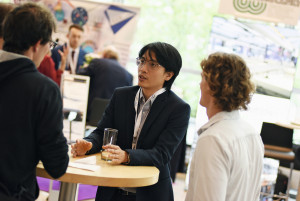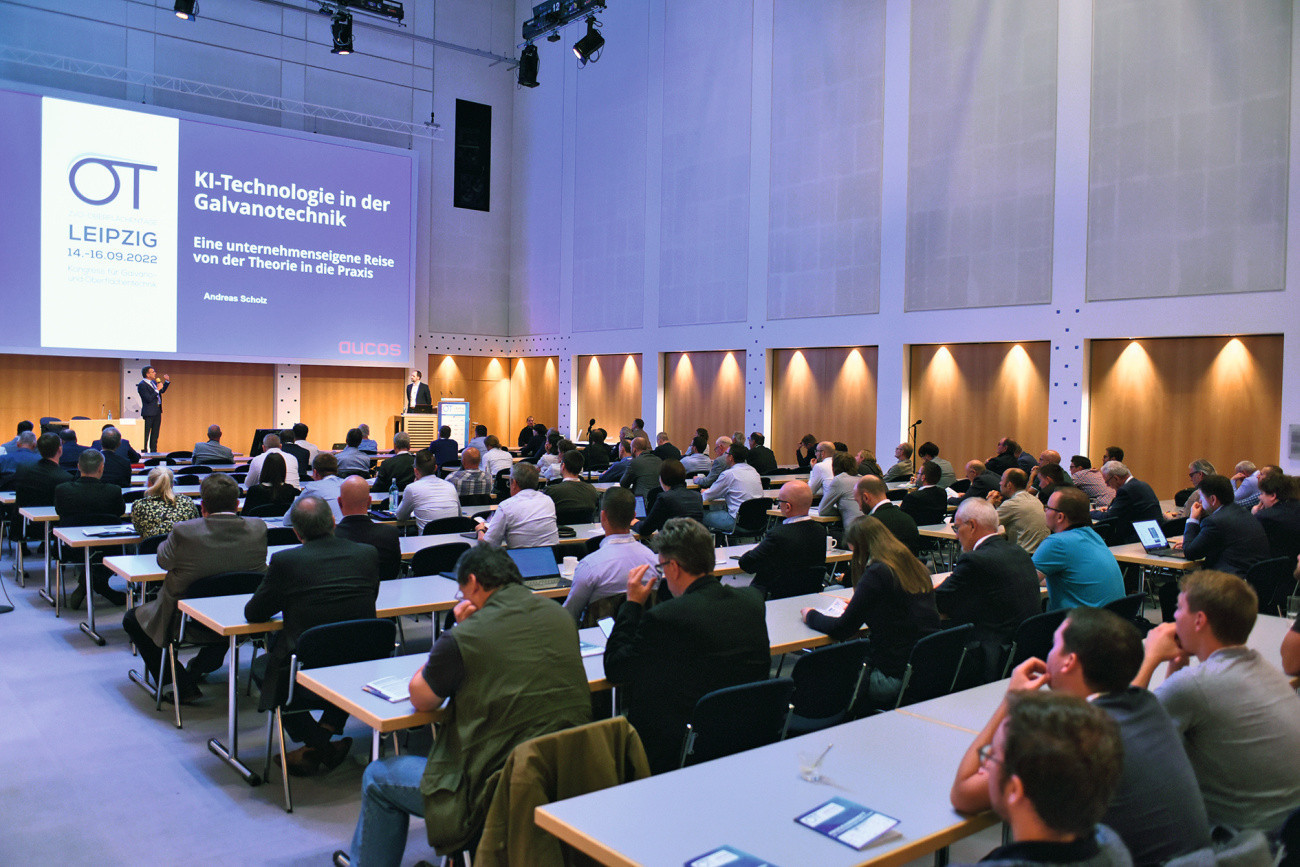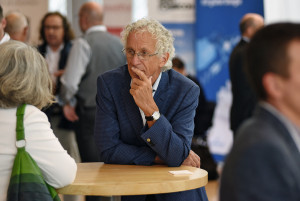- Part 3 - The last day of the conference once again offered a remarkable range of presentations. One exciting block of topics was "New requirements for electroplating and surface technology", which is reported on in full. In this final part of the Surface Days, the focus is also on advances in plant and control technology, which were already discussed in the afternoon of the previous day. This was mainly about digitalization and artificial intelligence (AI).
AI and digitalization in electroplating technology
 Young scientists exchanging expertise on the fringes of the eventAtthe beginning of his presentation, Andreas Scholz from Aucos AG posed the question of the practical benefits of using AI technology in surface technology.
Young scientists exchanging expertise on the fringes of the eventAtthe beginning of his presentation, Andreas Scholz from Aucos AG posed the question of the practical benefits of using AI technology in surface technology.
Using a Formula 1 racetrack as an example, Scholz illustrated the challenges faced by electroplating technology when using artificial intelligence in control technology. Using the example of driving program control, he explained how the best decisions and predictions can be made based on the analysis of existing values. Machine learning applications improve with their use and become more accurate the more data they have available. The neural network learns during use and optimizes other applications, for example for calculating the capacity of new plants. The focus here is on detecting coating errors even before the components have entered the system and dynamically calculating transport movements.
Sebastian Breuckmann from DITEC then spoke about the implementation of Electroplating 4.0 with a particular focus on predictive maintenance, electrolyte management, AI review, status and outlook. As a process-oriented industry, electroplating represents a particularly challenging field of application for the implementation of the Industry 4.0 concept due to the large number of input materials and interactions.
Breuckmann pointed out that significant steps are being taken today in electroplating technology towards the practical implementation of Electroplating 4.0. Maintenance management is about creating the most precise advance planning possible and avoiding unexpected system failures. With knowledge of the object-related maintenance history, resources for maintenance work such as required spare parts or personnel can be better planned. Plant availability can be increased by avoiding production downtimes due to faults and introducing planned maintenance stops, which generally require less maintenance. Electrolyte management is also the focus of developments, with a wide range of challenges and opportunities. The first step is to analyze the current status and then define the objectives for process optimization and ensuring a stable process. Breuckmann also highlighted some possible strategies for electrolyte management, such as correcting electrolyte parameters to target values after analysis or through regular corrections. The use of AI offers great potential for optimization.
New requirements for electroplating and surface technology New rack insulation system
 Women's power from Schwäbisch Gmünd: Heidi Willing (left) and Gloria Lanzinger from femAninnovative rack insulation system for chrome-free application in plastic electroplating was presented by Salvatore Bongiorno from Galvatore Plating & Equipment (read our technical article on p. 1563). This rack insulation system was developed to meet the latest EU requirements and enable plastics (ABS, ABS/PC and PA) to be plated without Cr(VI). The frame consists of a standard PVC on which an absorption barrier (specially developed fluoropolymer mixture) is applied. The layer thickness of the absorption barrier is usually 250-400 µm, the hardness 29-39 Shore D (Shore D hardness - testing of tough elastomers and thermoplastics) and the contact angle 95-114°. Previous tests have shown that the frame insulation system has a high thermal and chemical resistance in acidic media. The use of this rack system has drastically reduced the consumption of oxidizing agents and thus increased the stability of the pickling process. Chemical reactions can be prevented during pre-treatment. Further cost reductions result from the reduction of carry-over in the entire coating process and of waste water chemistry, which means that less metal sludge is produced. The improved rinsing effect results in lower consumption of process chemicals. Only the actual contact surface is coated. This also results in lower metal consumption (Cu/Ni). In contrast to conventional rack insulation, the formation of pores at the contacts and thus the risk of metal bud formation can be prevented. According to Bongiorno, the patent is expected to be granted at the end of 2022. Production of this frame variant is then set to begin in 2023. Manufacturers for these frames are still being sought.
Women's power from Schwäbisch Gmünd: Heidi Willing (left) and Gloria Lanzinger from femAninnovative rack insulation system for chrome-free application in plastic electroplating was presented by Salvatore Bongiorno from Galvatore Plating & Equipment (read our technical article on p. 1563). This rack insulation system was developed to meet the latest EU requirements and enable plastics (ABS, ABS/PC and PA) to be plated without Cr(VI). The frame consists of a standard PVC on which an absorption barrier (specially developed fluoropolymer mixture) is applied. The layer thickness of the absorption barrier is usually 250-400 µm, the hardness 29-39 Shore D (Shore D hardness - testing of tough elastomers and thermoplastics) and the contact angle 95-114°. Previous tests have shown that the frame insulation system has a high thermal and chemical resistance in acidic media. The use of this rack system has drastically reduced the consumption of oxidizing agents and thus increased the stability of the pickling process. Chemical reactions can be prevented during pre-treatment. Further cost reductions result from the reduction of carry-over in the entire coating process and of waste water chemistry, which means that less metal sludge is produced. The improved rinsing effect results in lower consumption of process chemicals. Only the actual contact surface is coated. This also results in lower metal consumption (Cu/Ni). In contrast to conventional rack insulation, the formation of pores at the contacts and thus the risk of metal bud formation can be prevented. According to Bongiorno, the patent is expected to be granted at the end of 2022. Production of this frame variant is then set to begin in 2023. Manufacturers for these frames are still being sought.
SAQ 4.0 automotive sustainability guideline
SAQ 4.0 is a self-assessment on the topic of sustainability in an internet platform jointly developed by the OEMs for all global suppliers, which Andreas Redaoui from TopQM-System AG spoke about. Automotive suppliers are expected to comply with and confirm guidelines for improving sustainability.
 The presentation on AI in electroplating captivated many industry experts
The presentation on AI in electroplating captivated many industry experts
The main chapters of SAQ 4.0 are:
- Management
- Working conditions and human rights
- Health and safety at work
- Business ethics (what is permissible)
- Environment (environmental guidelines, management systems)
- Supplier management (sustainability requirements for suppliers)
- Responsible procurement of raw materials
Redaoui then explained the seven main chapters and gave practical tips for uploading and completing the SAQ 4.0 Assessment Checklist using the example of the VW and BMW requirements. The number of employees for the verification documents and the ISO certification requirements is very important. With regard to data protection and the confidentiality of sensitive company data and participants' personal data, Redaoui pointed out that only the data that is released is published. With his remarks, he provided essential answers to the question of sustainability concepts in the company. Such documentation will be essential for automotive suppliers in the future.
Investing in climate-friendly drying with state funding
 Entrepreneur Ramisch did not hold back with criticism in Leipzig eitherModernplant engineering requires high-performance and energy-efficient processes, including in the area of component drying, according to Reinhold Specht from Harter GmbH. Completely dry components, stain-free surfaces, cycle time reduction and energy savings, whether on racks, in drums, baskets or on conveyor belts - these are topics that are being realized today. To achieve these objectives, Specht presented condensation drying based on heat pumps. The heart of condensation drying is the highly efficient dehumidification technology. By dehumidifying with extremely dry air in an energetically closed system, components are dried quickly, safely and in an energy-saving manner. Drying takes place in a variable temperature range from 20 to 90 °C, depending on requirements. Specht explained that a 75% energy saving is possible by using the presented drying system compared to conventional drying systems. As a supplement or option, a compressed air-free blow-off system can be offered either fixed or movable in the rack dryer or as a separate station. By using a powerful, highly efficient fan, large volumes of air can be generated which are distributed over the entire length of the blow-off bar rather than at specific points. This drying technology has been classified by the state as eligible for funding (federal funding for efficiency in the economy). The state subsidy is provided by the BafA (Federal Office of Economics and Export Control) and can be up to 40 % for SMEs and up to 30 % for large companies. According to Specht, applications are submitted to the BafA via the energy consulting service. The costs for this amount to approx. 3,000 euros. However, the costs for the energy consultation/application are also eligible for funding under Module 4.
Entrepreneur Ramisch did not hold back with criticism in Leipzig eitherModernplant engineering requires high-performance and energy-efficient processes, including in the area of component drying, according to Reinhold Specht from Harter GmbH. Completely dry components, stain-free surfaces, cycle time reduction and energy savings, whether on racks, in drums, baskets or on conveyor belts - these are topics that are being realized today. To achieve these objectives, Specht presented condensation drying based on heat pumps. The heart of condensation drying is the highly efficient dehumidification technology. By dehumidifying with extremely dry air in an energetically closed system, components are dried quickly, safely and in an energy-saving manner. Drying takes place in a variable temperature range from 20 to 90 °C, depending on requirements. Specht explained that a 75% energy saving is possible by using the presented drying system compared to conventional drying systems. As a supplement or option, a compressed air-free blow-off system can be offered either fixed or movable in the rack dryer or as a separate station. By using a powerful, highly efficient fan, large volumes of air can be generated which are distributed over the entire length of the blow-off bar rather than at specific points. This drying technology has been classified by the state as eligible for funding (federal funding for efficiency in the economy). The state subsidy is provided by the BafA (Federal Office of Economics and Export Control) and can be up to 40 % for SMEs and up to 30 % for large companies. According to Specht, applications are submitted to the BafA via the energy consulting service. The costs for this amount to approx. 3,000 euros. However, the costs for the energy consultation/application are also eligible for funding under Module 4.
Recovering valuable materials from acids, alkalis and metals
Rainer Klein from Spiraltec GmbH presented the wound membrane module developed by his company for diffusion analysis for the recovery of acids, alkalis and metals. The membrane separation process is based on the flow of two different fluids through two channels, which are separated by a semi-permeable selective membrane. The process is possible in co-current or counter-current.
The spiral membrane module has a compact design (module height 600 mm, diameter 210 mm) and can be flexibly configured thanks to its modular design (1-10 modules). Each module can regenerate approx. 15 l/h of bath solution.
Klein went on to explain that this module can achieve up to 90-95% acid recovery, up to 75% alkali recovery and up to 98% metal recovery, depending on the selected volume flow ratio and metal concentration. He presented the following application examples:
- Sulphuric acid steel pickling recycling (recovery of acid by prefiltration, microfiltration, diffusion dialysis)
- Aluminum bright bath recycling (dilution station, diffusion dialysis, cation exchanger, evaporator)
- Sulphuric acid copper sulphate solution (recovery of acid, electrolysis of copper sulphate by prefiltration, microfiltration, diffusion dialysis, electrolysis)
- Recovery of the HCl pickle during hot-dip galvanizing (prefiltration, ultrafiltration to separate the oil, diffusion dialysis)
The targeted use of diffusion dialysis as an intermediate stage makes it possible to increase the economic efficiency of an overall recycling process. The increase in chemical prices could open up interesting additional fields of application for the membrane module, as, in contrast to the use of ion exchangers, no large quantities of chemicals are used for the regeneration of the resins.
Corrosion protection requirements for decorative chrome plating in automobiles: Cr(III) vs. Cr(VI)
Rolf Pofalla, MacDermid Enthone GmbH, began by making it clear that Cr(III) coating has become an integral part of the automotive sector and is now well established. Legal requirements (such as REACh) and the interest in environmentally friendly processes, trends towards individualization (color) and special requirements for corrosion protection have led to a growing use of Cr(III) processes in recent years.
Different requirements in OEM specifications are important criteria when implementing a suitable Cr(III) process. The following key aspects need to be considered, as Pofalla went on to explain:
- Electrolyte composition and achievable layer properties (color values)
- Influence of the coating composition on the coating thickness measurement (light coatings measured using standard methods, a correction factor is required for dark coatings)
- Anode material (investigations are underway to eliminate iridium anodes, possible use of mixed oxide anodes)
- Anode service life
- Post-treatment (very frequent use, check whether absolutely necessary, REACh conformity)
- Influence of post-treatment processes on wastewater pollution and treatment
- Influence of complexing agents on wastewater treatment
These aspects are criteria for process optimization.
Chromium(VI)-free chemical galvanic coating of additively manufactured plastic parts
The additive manufacturing of plastic components has become much more important in recent years, according to Dr. Jürgen Hofinger from Biconex GmbH. The 3D printing of metals is now also established, but has higher technical hurdles to overcome compared to plastics. This makes combination processes based on the production of plastic components with subsequent electroplating all the more interesting. Biconex GmbH focuses on processes for the pre-treatment of plastics from 3D printing for subsequent chemical or galvanic coating. The focus here is on the development of new chromium(VI)-free processes. In his overview lecture, Hofinger presented the current 3D printing technologies and possible pre-treatment coating technologies:
- FDM (Fused Deposition Modeling): most widely used 3D printing technology, low-cost equipment available
- SLS (selective laser sintering): thermally resilient, slightly rough surface, therefore good adhesive strength, no aggressive pickling required, structure not completely dense
- MJK (Multi Jet Fusion): These plastics offer the best option for subsequent coating, adhesion not as good as with SLS, no aggressive pickling, fast printing possible
- SLA (stereolithography): oldest process, delivers high-precision, isotropic components with a smooth surface, pickling required, coating success is very material-dependent
Hofinger went on to explain that a PVD coating is well suited as a starting layer, but is highly geometry-dependent. The coating reaches its limits with complex geometries. And the frame attachment of the components is also an essential prerequisite for order processing.
Fe-Cr-Ni alloys and the consideration of deposition from Cr(III) electrolytes
Dominik Höhlich works in the Department of Materials and Surface Technology at Chemnitz University of Technology. High-alloy steels are used as standard for applications that place high demands on corrosion and wear resistance, he stated at the outset. The investigations at Chemnitz University of Technology are concerned with testing a replacement through the use of low-alloy steels with Fe-Cr-Ni coatings, deposited from Cr(III) electrolytes. Electroplating this alloy could be of great economic interest, as it could also be an alternative to bright chromium systems (deposited from Cr(III) electrolytes). A direct application of crack-free and thick (> 10µm) Fe-Cr-Ni alloy layers offers the advantage that copper and/or nickel intermediate layers can be dispensed with. Höhlich presented the current results of the investigations. Investigations were carried out with different current densities, pulse current and stepped direct current. With the latter (10s on, 5s off), good layers with a Cr content of 26 % could be deposited. A crack-free coating with a hardness significantly higher than Cr-Ni steel can be deposited. No loss of hardness could be registered due to the staged deposition. The layer thickness is 10 µm.
The hardness of the hard chrome layer has not yet been achieved with the tests carried out. The development topic will be continued and the focus will be on increasing the hardness of the deposited layer.
Statement
 Dr. Michael Schem, R&D McDermid Enthone Industrial Solutions - Coventia GmbH, on supply bottlenecks and the impact on theindustrySurfing the waves as they come
Dr. Michael Schem, R&D McDermid Enthone Industrial Solutions - Coventia GmbH, on supply bottlenecks and the impact on theindustrySurfing the waves as they come
"The entire industry is suffering from the shortage of raw materials. It's amazing how even standard chemicals are now in short supply. This shows the upheaval we are currently experiencing. I have the impression that we are now realizing how thin ice we are actually standing on. We have to make sure that we diversify more and can't just rely on one distributor. But the market for standard chemicals is still empty. We need several mainstays and have to surf the waves as they come."
Chromium(VI) ban in gravure printing - options and alternative systems
In gravure printing, steel rollers are copper-plated, then imaged and finally chrome-plated, explained speaker Dr. Julius Gröne from Matthews International. Chrome plating is currently still carried out using electrolytes containing Cr(VI). But here, too, there is a need to replace these Cr(VI)-containing electrolytes with other coating systems. These coating systems must be comparable in terms of the relevant properties (high hardness, very good abrasion resistance, very good tarnish protection, good corrosion protection, microcracks) and at the same time be cost-compatible.
The following alternative coating systems have been investigated to date:
- Cylindrical nickel plating: problems due to abrasion
- Electroless nickel: too expensive
- Zinc-nickel: good hardness, good impression, but the results are not very good, further investigations will follow
- Cr(III): Problems arose due to the hardness of the coating, the corrosion protection, the effort involved in coating and the costs.
The coatings were tested using color testers with regard to screen printing, pressure behavior and the resistance of the coating. In summary, it can be said that all the coating systems mentioned did not achieve the required success. The company is hoping for further funding and asked for support in solving the problem of Cr(VI) electrolyte detachment in gravure printing.


